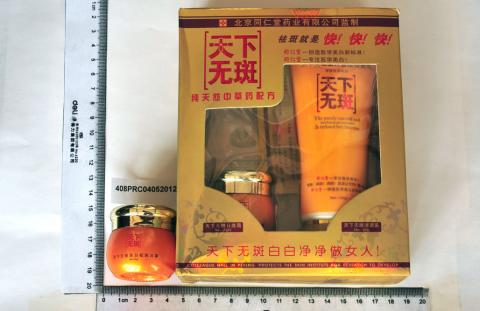China Skin Products Study

In China, mercury is limited to 1ppm in skin-lightening and freckle-removing products due to concerns over exposure and harm to health. In this study, Green Beagle and IPEN collaborated with Chinese NGOs in 10 provinces to determine whether skin-lightening products containing high levels of mercury are available on the market in China. Products were purchased online and in stores and markets located in Beijing (Beijing Municipality), Chongqing (Sichuan Province), Dongguan (Guangdong Province), Harbin (Heilongjiang Province), Hefei (Anhui Province), Nanjing (Jiangsu Province), Lanzhou (Gansu Province), Panjin (Liaoning Province), Shanghai (Shanghai Municipality), and Tianjin (Tianjin Municipality).
Mercury was measured using a portable X-ray fluorescence analyzer (XRF) which was calibrated using laboratory measurements of products. The XRF device is routinely used by companies and government regulatory agencies for metals detection in food, consumer products and other media.
We found 112 products (23%) that violated the Chinese regulatory limit for mercury of 1 ppm. Mercury concentrations in products ranged from 18 ppm to nearly 44,000 ppm. The top five products contained mercury at concentrations ranging from 17,918 ppm to 43,988 ppm. These products should not be for sale on the Chinese market.
Skin-lightening products were also found that exceeded Chinese regulatory limits for arsenic (10 ppm) and lead (40 ppm). Forty-six products contained arsenic, lead, or both metals. Forty-four of the 46 products violated the Chinese regulatory limit for arsenic. Twenty products in this group exceeded the Chinese regulatory limit for lead (40 ppm) and 28 exceeded the ASEAN limit for lead (20 ppm). Twenty-three products contained all three metals; mercury, arsenic, and lead. The presence of more than one toxic metal in a product applied directly to the body increases the possibility of harm.
All of the products in the current study that violate the regulatory limit for mercury were readily available on the market in stores located in 10 cities in 10 different provinces. In addition, products containing high levels of mercury were available for purchase throughout the country from the popular on-line retailer, Taobao. None of the products we tested were labeled to indicate mercury, arsenic, or lead content.
To our knowledge, this is the largest publicly available investigation of mercury in skin-lightening and freckle-removing products in China.
Recommendations
FOR THE INDUSTRY:
- Manufacturers and formulators should obey Chinese laws, immediately phase out mercury and other toxic chemicals, and shift to safer ingredients
- Retailers should remove products violating Chinese law from sale. Products identified containing greater than 1 ppm mercury or 10 ppm arsenic or 40 ppm lead should be removed from store shelves and internet websites
- Manufactures should actively generate and disclose the chemical content of skin-lightening products and other cosmetics as a condition for sale in China
- Manufacturers should promote the design and development of safer cosmetic products using green design, safe natural materials, and green chemistry
FOR THE GOVERNMENT:
- Issue an advisory that requires removal from sale all skin-lightening products identified containing greater than 1ppm mercury
- Re-classify skin whitening products as cosmetics of specific use to bring them under greater regulatory control
- Work with civil society organizations to conduct a continuing public information drive to educate local government officials, consumers and other stakeholders about the risks posed by mercury in cosmetics
FOR CONSUMERS:
- The safest way for consumers to protect themselves is to accept their natural skin tone and avoid the use of skin-lightening products.
- Support policies requiring the disclosure of chemical content as a condition for sale of cosmetic products
